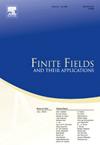多扭曲码伽罗瓦壳的生成多项式矩阵
IF 1.2
3区 数学
Q1 MATHEMATICS
引用次数: 0
摘要
本文考虑特征为p的有限域Fpe上的多扭曲码的欧几里得壳和伽罗瓦壳。设G为多扭曲码C的生成多项式矩阵(GPM)。对于任意0≤κ<;e, C的κ-伽罗瓦壳表示为C与其κ-伽罗瓦对偶的交。本文的主要结果是从g中得到了hκ(C)的GPM。我们首先将线性码QG与g关联,并证明了QG是拟循环的。此外,我们还证明了hκ(C)的维数是C与QG的维数之差。因此,行列式除数被用来推导出hκ(C)维数的公式。最后,我们推导出hκ(C)的GPM公式。特别地,我们处理了κ-伽罗瓦自正交和线性互补对偶MT码的情况;我们建立了表征这些情况的等价条件。对于循环码、恒循环码、拟循环码、广义拟循环码和拟扭曲码,由于它们都是MT码的特殊情况,所以可以立即推导出等价的结果。一些数值例子,包含代码与最知名的参数,用来说明理论结果。本文章由计算机程序翻译,如有差异,请以英文原文为准。
Generator polynomial matrices of the Galois hulls of multi-twisted codes
In this study, we consider the Euclidean and Galois hulls of multi-twisted (MT) codes over a finite field of characteristic p. Let G be a generator polynomial matrix (GPM) of an MT code . For any , the κ-Galois hull of , denoted by , is the intersection of with its κ-Galois dual. The main result in this paper is that a GPM for has been obtained from G. We start by associating a linear code with G. We show that is quasi-cyclic. In addition, we prove that the dimension of is the difference between the dimension of and that of . Thus the determinantal divisors are used to derive a formula for the dimension of . Finally, we deduce a GPM formula for . In particular, we handle the cases of κ-Galois self-orthogonal and linear complementary dual MT codes; we establish equivalent conditions that characterize these cases. Equivalent results can be deduced immediately for the classes of cyclic, constacyclic, quasi-cyclic, generalized quasi-cyclic, and quasi-twisted codes, because they are all special cases of MT codes. Some numerical examples, containing codes with the best-known parameters, are used to illustrate the theoretical results.
求助全文
通过发布文献求助,成功后即可免费获取论文全文。
去求助
来源期刊
CiteScore
2.00
自引率
20.00%
发文量
133
审稿时长
6-12 weeks
期刊介绍:
Finite Fields and Their Applications is a peer-reviewed technical journal publishing papers in finite field theory as well as in applications of finite fields. As a result of applications in a wide variety of areas, finite fields are increasingly important in several areas of mathematics, including linear and abstract algebra, number theory and algebraic geometry, as well as in computer science, statistics, information theory, and engineering.
For cohesion, and because so many applications rely on various theoretical properties of finite fields, it is essential that there be a core of high-quality papers on theoretical aspects. In addition, since much of the vitality of the area comes from computational problems, the journal publishes papers on computational aspects of finite fields as well as on algorithms and complexity of finite field-related methods.
The journal also publishes papers in various applications including, but not limited to, algebraic coding theory, cryptology, combinatorial design theory, pseudorandom number generation, and linear recurring sequences. There are other areas of application to be included, but the important point is that finite fields play a nontrivial role in the theory, application, or algorithm.

 求助内容:
求助内容: 应助结果提醒方式:
应助结果提醒方式:


